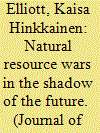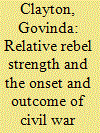| Srl | Item |
| 1 |
ID:
167278


|
|
|
|
|
| Summary/Abstract |
Previous studies on natural resources and civil wars find that the presence of natural resources increases both civil conflict risk and duration. At the same time, belligerents often cooperate over resource extraction, suggesting a temporal variation in the contest over this subnational space. This study argues that parties fight over natural resources primarily when they expect that the conflict is about to end, as the importance of controlling them increases in the post-conflict setting. In contrast, belligerents that anticipate a long war have incentives to avoid fighting near natural resources since excessive violence will hurt the extraction, trade, and subsequent taxation that provide conflict actors with income from the resource. We test our argument using yearly and monthly grid-cell-level data on African civil conflicts for the period 1989–2008 and find support for our expected spatial variation. Using whether negotiations are underway as an indicator about warring parties’ expectations on conflict duration, we find that areas with natural resources in general experience less intense fighting than other areas, but during negotiations these very areas witness most of the violence. We further find that the spatial shift in violence occurs immediately when negotiations are opened. A series of difference-in-difference estimations show a visible shift of violence towards areas rich in natural resources in the first three months after parties have initiated talks. Our findings are relevant for scholarship on understanding and predicting the trajectories of micro-level civil conflict violence, and for policymakers seeking to prevent peace processes being derailed.
|
|
|
|
|
|
|
|
|
|
|
|
|
|
|
|
| 2 |
ID:
124111


|
|
|
|
|
| Publication |
2013.
|
| Summary/Abstract |
To what extent does the relative strength of a rebel movement impact upon the likelihood of a peace settlement in civil conflict? This article argues that relatively stronger rebels are more likely to overcome the strategic bargaining problems that can prevent the resolution of war. Relatively strong insurgents are better equipped to significantly challenge core government interests and fundamentally threaten the survival of a regime. The incumbent's fear of future violence therefore makes mediation more likely to be undertaken in high-stakes conflicts between states and strong rebel groups. Relatively strong insurgencies are also those with the greatest leverage to negotiate enforcement mechanisms and the best equipped to defend themselves in the event that the government reneges on an agreement. This reduces the scale of the commitment problem and increases the probability of relatively strong rebel groups agreeing to a settlement with an incumbent. This argument is tested using dyadic data that capture the relative position of insurgents in civil war from 1946 to 2004. This represents an important methodological shift within the mediation literature, which has in the past largely relied upon aggregate country-level data. The results suggest that relatively stronger insurgents are more likely to force the state to open a mediation process and eventually concede some form of settlement. This is further evidence of the need to capture the dyadic relations between actors with fine-grained disaggregated data.
|
|
|
|
|
|
|
|
|
|
|
|
|
|
|
|